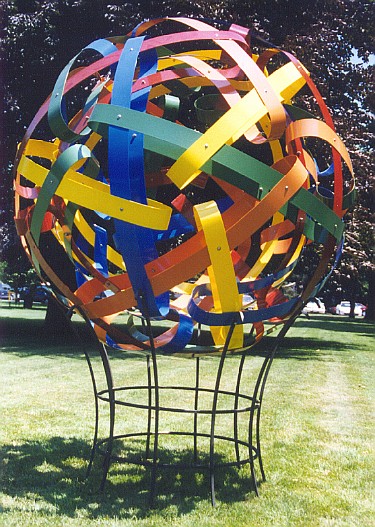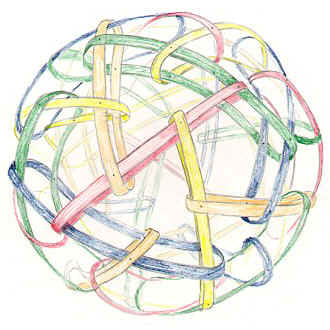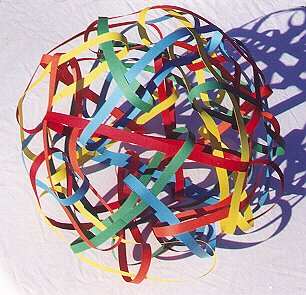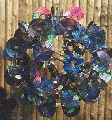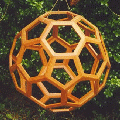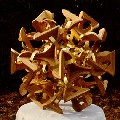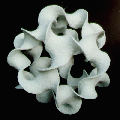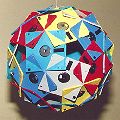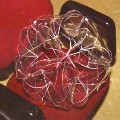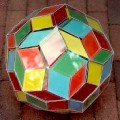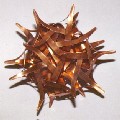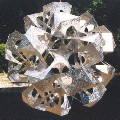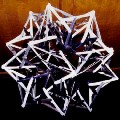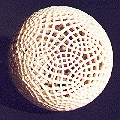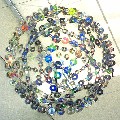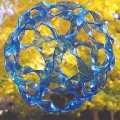The Geometric Designs and Sculpture of
Dr. George W. Hart
Introduced by Gina Lynne LoSasso
I first met George (in the virtual sense) about a year and a half ago, when I was hunting the web for ideas for an Ultranet logo. Since the Mega Foundation Logo had used a compound cube to represent a shared vision, I was hoping to find a complex compound polyhedron to represent the melding of individual minds within the Global UltraHIQ Community. Before I knew it, I had stumbled into George Hart's world via his amazing Encyclopedia of Polyhedra.
I quickly realized that one of the most amazing parts of this world was George's incredible geometric art, characterized by a careful blending of mathematics and visual appeal that can be traced to ancient times. Although this kind of sculpture is often judged to have reached its pinnacle in the Renaissance, many of George's designs are unprecedented in the history of art (see the following entry from the Encyclopedia of Polyhedra: Polyhedra and Art).
George's sculptures range in size from just a few inches (see Gonads of the Rich and Famous) to large outdoor entries like "Loopy" (above), a painted aluminum sculpture that is almost 6 feet in diameter and stands 8 feet tall on its steel base.
For the creation of "Loopy", George began with a colored pencil sketch. He then created a 3-dimensional model made from paper strips of five different colors. Loopy is constructed of 30 rolled loops, each 10 feet long. The loops are interwoven and bolted together in a striking pattern.
Each one of his remarkable sculptures invites contemplation. Because they slowly reveal their content over extended and repeated viewings, some viewers see them as meditation objects. George uses a variety of media, from traditional woods and metals to the stuff of modern art: CDs, computer discs, pencils and plastic serving-ware. Each piece is unique and, as George puts it, "The integral wholeness of each self-contained sculpture presents a crystalline purity, a conundrum of complexity, and a stark simplicity."
I
asked George to tell me a little bit about how and when he started making his
geometric sculptures.
"As a youth, (roughly
12-14) I made many large structures by gluing hundreds and hundreds of
toothpicks together. Some were architectural or structural, others
representational (like rockets), and many were mathematical, e.g., polyhedra. I
was greatly impressed by the book Mathematical Models by Cundy and
Rollett (which I had out of the library for several years). I made many
intricate paper polyhedra models from its instructions. I also was an admirer of
Picasso's art and all sorts of abstract sculpture, especially constructive
sculpture, and Calder most especially. Somehow these threads came together as I
grew older. I think the commonality lies in visual thinking---that is what
ties together art and mathematics so strongly for me." Below is a picture of George's
office. The pieces that he's working on, and has hanging up, change
from time to time, but
the atmosphere on a typical day is captured nicely.
George's
latest book, Zome
Geometry, introduces the reader to the fantastic world of 3D geometric
construction using the Zome System, a
31-zone construction system inspired by crystallographers.
More Geometric Sculptures by George W. Hart
|
|
Propello-octahedron
150 CDs 26"
|
|
Leonardo Project Cherry reconstructions of Leonardo da Vinci's Models |
|
|
|
|
|
|
|
|
|
Fire and Ice
oak and brass
|
|
Battered Moonlight
paper mache over steel
|
|
|
|
|
|
|
|
|
|
Disk Combobulation
3.5 inch floppy diskettes
|
|
I'd like to make one thing perfectly clear
acrylic plastic
|
|
|
|
|
|
|
|
|
|
The Color-Matched Dissection of the Rhombic Enneacontahedron
acrylic plastic shell, acid-free card stock
|
|
Gazmogenesis
copper
|
|
|
|
|
|
|
|
|
|
Whoville
aluminum
|
|
The Plastic Tableware of Damocles
180 plastic knives
|
|
|
|
|
|
||
|
|
Gonads of the Rich and Famous 3D printing
|
|
Rainbow Bits
642 CD-ROMs
|
|
|
|
|
|
|
|
|
|
The Susurrus of the Sea
transparent blue acrylic plastic
|
|
Roads Untaken
exotic hardwoods (yellowheart, paella, and padauk) with walnut "grout,"
|
|
|
|
|
|
|
|
|
Millennium Bookball
Wood and bronze, 5 foot diameter |
|
Labia
360 CDs
|
Copyright © 2001 by George W. Hart. All rights reserved. All photos and quotes printed with permission. Members are encouraged to visit www.georgehart.com for links to Dr. Hart's research papers, mathematical and computer designs, and 2D blueprints for constructions two difficult to create physically.

